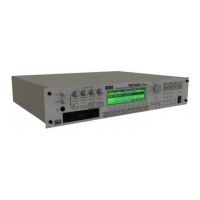96
The noise occurring at the end of the sample in “C.” will
be automatically reduced when you execute steps
8 and
following. You should adjust “Sensitivity” while paying
particular attention to sections “A” and “B,” and then
execute step
9. If the noise is still obtrusive, then you can
adjust the end address.
8 Save the sliced samples to the multisample to which they
have been assigned. When you press the [F6] (“Save”)
key, the “Save Smpl/MS” dialog box will appear.
9 Use “Stretch” to adjust the length of the sliced samples.
When you press the [F5] (“Strch”) key, Time Stretch (a
function that expands or shrinks the length of a sample
without affecting its pitch) will be applied to the sliced
sample.
If you wish to save the sliced sample as it is, proceed to
step
0 without executing Time Stretch.
When a sliced sample is played in Multi mode, or when
saved pattern data is played from an external MIDI
sequencer, slowing down the playback tempo may pro-
duce an unnatural impression, such as the silent portion
between samples becoming more noticeable, or noise
being heard. The length of the samples will automatically
be optimized according to the “Ratio” and “New BPM”
settings.
If you execute Time Stretch at 100%, the sample length
will not change but the end of the sample will be faded
out, reducing the noise.
a) Set “Beat” and “Src BPM (Source BPM).” The method is
the same as in step
3. If you wish to change the value
you set in step
3, you can change it here.
b) Specify the length of the sample that will be created by
Time Stretch.
• To specify the length as a ratio
Set “Ratio.” The available range is 50.00–200.00%. If you
specify 50.00%, the sample length will be halved. (The
tempo will double.) If you specify 200.00%, the sample
length will double. (The tempo will be halved.)
• To match an existing BPM tempo value
Use “New BPM” to specify the BPM value of the sample
you wish to create. The “Ratio” will automatically be cal-
culated from the “Src BPM (Source BPM)” and the “New
BPM” values.
It is not possible to make settings that would cause “Src
BPM (Source BPM)” or “New BPM” to exceed the range
of 40–480.
It is not possible to make settings that would cause
“Ratio” to exceed the range of 50.00–200.00.
Press the [F5] (“Strch”) key to execute Time Stretch. When
you execute, the time-stretched samples will automatically
be assigned to keys D2 and above, so that you can audition
them by playing the keyboard of a connected MIDI device
or by changing “Index” and pressing the [AUDITION] key.
You can also keep trying various settings for “Ratio” and
“New BPM.”
Index: Select s the index of the sample that will be sounded
by the [AUDITION] key. After Time Stretch is executed, the
time-stretched samples will sound. However, it will not be
possible to select Source (C2).
Audition the time-stretched samples. The sounds that
you hear are the divided samples that will be played in
Multi mode etc. If there is obtrusive noise or if the
attack is not sound cleanly, return to step
7 and adjust
the “S (Start)” and “E (End)” addresses, etc.
0 When you execute Save, use “With” to specify the data
that will be created simultaneously.
Program: If this check box is checked, the multisample
will be converted to a program when you save it. Specify
the destination program number.
In the case of a stereo sample, the program pan
will automatically be set. This allows the stereo position
in Sampling mode to be reproduced by the program.
Seq.Event: If this check box is checked, pattern data to
play the sliced samples will be created when you save.
Set “Multi,” “Pattern,” and “Meter” to specify the multi
number, pattern number, and time signature that will be
created.
When you create pattern data, Multi mode “Tempo”
(MULTI 1.1–1a) will be set to the value specified by “New
BPM” if Time Stretch is executed, or to the value speci-
fied by “Src BPM (Source BPM)” if Time Stretch is not
executed.
RPPR: If you check the check box, pattern data to play
the sliced samples will be assigned to RPPR when you
save. Use “Key” and “Track” to specify the key and track
that will be created.
You can hear the results immediately by selecting the
specified multi and pattern in Multi mode and playing it.
If you have specified RPPR, the pattern will play when
you press the specified note on a connected MIDI instru-
ment.
Normally you will check both “Program” and
“Seq.Event”
In some cases, the sample End address setting etc. may
increase the number of measures in the pattern, so that
it no longer loops precisely. In such cases, re-specify the
“Length” in Multi mode “Pattern Parameter” (MULTI
5.1–1e: UTILITY).
A If you wish to save, press the [F8] (“Save”) key. If you
decide not to save, press the [F7] (“Cancel”) key. When
you save, the samples and multisample will automati-
cally be saved to vacant samples and multisamples.
In the case of stereo samples, the samples and
multisample will be saved in stereo.
B By repeating steps 6–A you can create as many samples
and multisamples as desired.
C Press the [F7] (“Exit”) key to exit the Time Slice com-
mand.
Be aware that the created samples and multisample will
be lost if you exit Time Slice without saving the samples
or multisample (“Save” in the Save dialog box).
Not stretched
Stretched with
Ratio 150%
Not stretched Stretched with
Ratio 50%
Time Stretch Time Stretch
Silent
Noise

